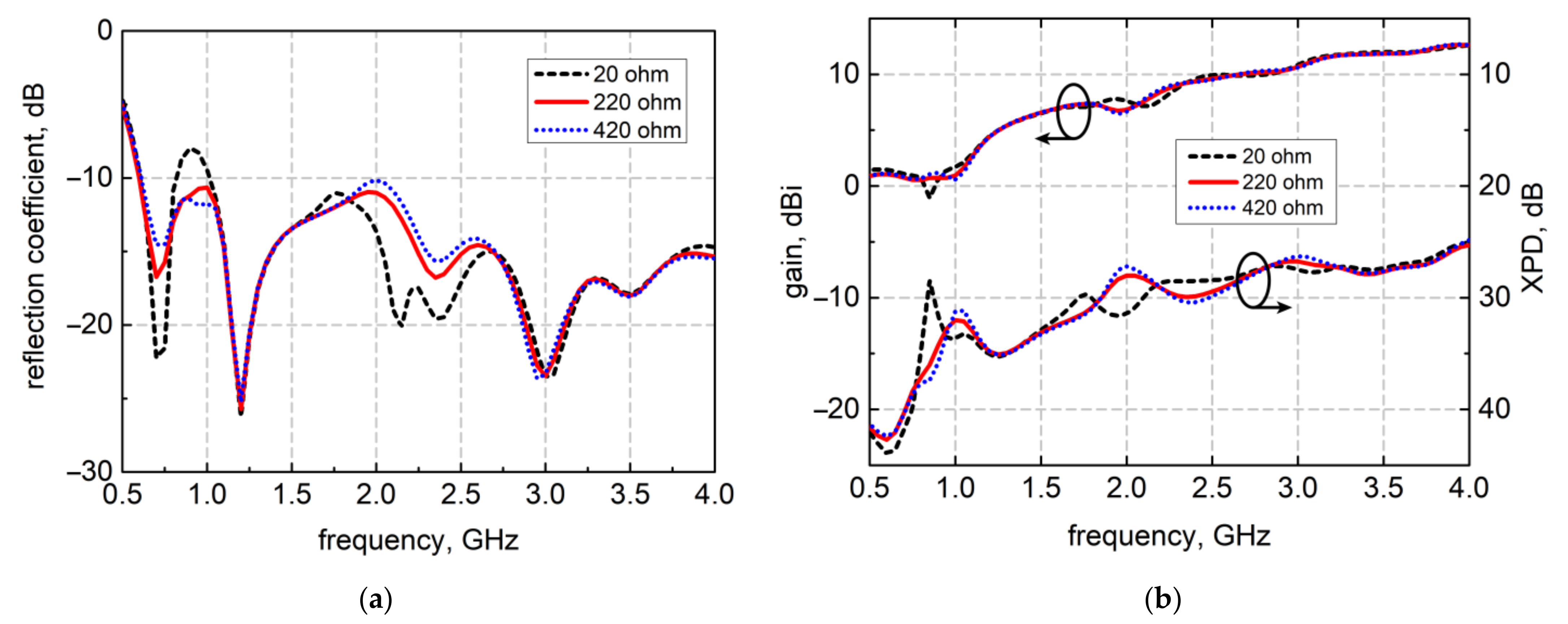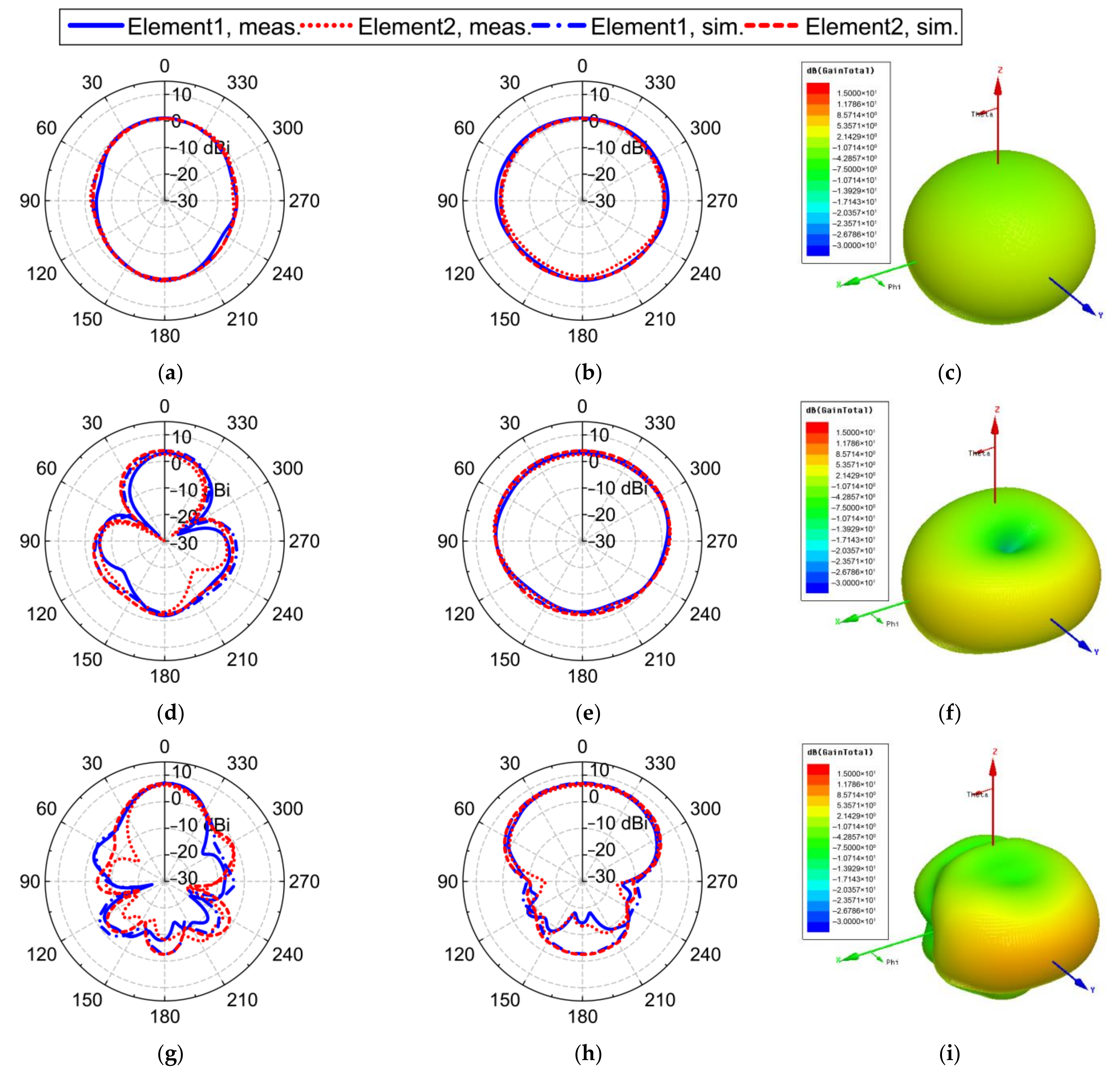Dual-Polarized Dual-Loop Double-Slot Antipodal Tapered Slot Antenna for Ultra-Wideband Radar Applications
Abstract
:1. Introduction
2. Antenna Geometry and Design
2.1. Radiating Structure
2.2. Feeding Structure
3. Results
4. Discussion
5. Conclusions
Author Contributions
Funding
Conflicts of Interest
References
- Wang, X.-Y.; Tang, S.-C.; Yang, L.-L.; Chen, J.-X. Differential-Fed Dual-Polarized Dielectric Patch Antenna with Gain Enhancement Based on Higher Order Modes. IEEE Antennas Wirel. Propag. Lett. 2020, 19, 502–506. [Google Scholar] [CrossRef]
- Park, J.; Johnson, J.T.; Majurec, N.; Frankford, M.; Stewart, K.; Smith, G.E.; Westbrook, L. Simulation and analysis of polarimetric radar signatures of human gaits. IEEE Trans. Aerosp. Electron. Syst. 2014, 50, 2164–2175. [Google Scholar] [CrossRef]
- Li, M.; Li, Q.L.; Wang, B.; Zhou, C.F.; Cheung, S.W. A Low-Profile Dual-Polarized Dipole Antenna Using Wideband AMC Reflector. IEEE Trans. Antennas Propag. 2018, 66, 2610–2615. [Google Scholar] [CrossRef]
- Mirmozafari, M.; Zhang, G.; Fulton, C.J.; Doviak, R.J. Dual-Polarization Antennas with High Isolation and Polarization Purity: A Review and Comparison of Cross-Coupling Mechanisms. IEEE Antennas Propag. Mag. 2018, 61, 50–63. [Google Scholar] [CrossRef]
- Liu, Y.; Zhou, W.; Yang, S.; Li, W.; Li, P.; Yang, S. A Novel Miniaturized Vivaldi Antenna Using Tapered Slot Edge with Resonant Cavity Structure for Ultrawideband Applications. IEEE Antennas Wirel. Propag. Lett. 2016, 15, 1881–1884. [Google Scholar] [CrossRef]
- Wang, N.-N.; Fang, M.; Chou, H.-T.; Qi, J.-R.; Xiao, L.-Y. Balanced Antipodal Vivaldi Antenna with Asymmetric Substrate Cutout and Dual-Scale Slotted Edges for Ultrawideband Operation at Millimeter-Wave Frequencies. IEEE Trans. Antennas Propag. 2018, 66, 3724–3729. [Google Scholar] [CrossRef]
- Li, X.; Zhou, H.; Gao, Z.; Wang, H.; Lv, G. Metamaterial Slabs Covered UWB Antipodal Vivaldi Antenna. IEEE Antennas Wirel. Propag. Lett. 2017, 16, 2943–2946. [Google Scholar] [CrossRef]
- Wang, Y.; Wang, G.; Gao, X.; Zhou, C. Double-slot Vivaldi antenna with improved gain. Electron. Lett. 2013, 49, 1119–1121. [Google Scholar] [CrossRef] [Green Version]
- So, Y.; Kim, W.; Kim, J.; Yong, Y.J.; Park, J. Double-slot antipodal Vivaldi antenna for improved directivity and radiation patterns. In Proceedings of the 2016 International Symposium on Antennas and Propagation (ISAP), Okinawa, Japan, 24–28 October 2016; pp. 382–383. [Google Scholar]
- Wang, Y.-W.; Yu, Z.-W. A Novel Symmetric Double-Slot Structure for Antipodal Vivaldi Antenna to Lower Cross-Polarization Level. IEEE Trans. Antennas Propag. 2017, 65, 5599–5604. [Google Scholar] [CrossRef]
- Malakooti, S.-A.; Moosazadeh, M.; Ranasinghe, D.C.; Fumeaux, C. Antipodal Vivaldi Antenna for Sum and Difference Radiation Patterns With Reduced Grating Lobes. IEEE Antennas Wirel. Propag. Lett. 2017, 16, 3139–3142. [Google Scholar] [CrossRef]
- Zhang, Y.; Li, E.; Wang, C.; Guo, G. Radiation Enhanced Vivaldi Antenna With Double-Antipodal Structure. IEEE Antennas Wirel. Propag. Lett. 2016, 16, 561–564. [Google Scholar] [CrossRef]
- Zhu, S.; Liu, H.; Wen, P.; Du, L.; Zhou, J. A Miniaturized and High Gain Double-Slot Vivaldi Antenna Using Wideband Index-Near-Zero Metasurface. IEEE Access 2018, 6, 72015–72024. [Google Scholar] [CrossRef]
- Sonkki, M.; Sanchez-Escuderos, D.; Hovinen, V.; Salonen, E.T.; Ferrando-Bataller, M. Wideband Dual-Polarized Cross-Shaped Vivaldi Antenna. IEEE Trans. Antennas Propag. 2015, 63, 2813–2819. [Google Scholar] [CrossRef] [Green Version]
- Dzagbletey, P.A.; Shim, J.Y.; Jeong, J.Y.; Chung, J.-Y. Dual-polarized Vivaldi antenna with quarter-wave balun feeding. In Proceedings of the 2017 Asia-Pacific International Symposium on Electromagnetic Compatibility (APEMC), Seoul, Korea, 20–23 June 2017; pp. 108–110. [Google Scholar]
- Song, L.; Zhou, H. Wideband dual-polarized Vivaldi antenna with improved balun feed. Int. J. Microw. Wirel. Technol. 2018, 11, 41–52. [Google Scholar] [CrossRef]
- Chen, D.; Wang, K.; Zhu, W.; Wang, L.; Liu, Z.; Wang, T.; Gao, J.; Zhu, S. 2–40 GHz dual-band dual-polarised nested Vivaldi antenna. IET Microw. Antennas Propag. 2019, 13, 163–170. [Google Scholar] [CrossRef]
- Kim, W.; Park, J.; Park, H.; Yoon, Y.J. Radiation characteristics enhancement of dual-polarized antipodal Vivaldi antenna using double-slot structure. Microw. Opt. Technol. Lett. 2019, 62, 1245–1251. [Google Scholar] [CrossRef]
- Cicchetti, R.; Cicchetti, V.; Faraone, A.; Foged, L.; Testa, O. A Compact High-Gain Wideband Lens Vivaldi Antenna for Wireless Communications and Through-the-Wall Imaging. IEEE Trans. Antennas Propag. 2020, 69, 1. [Google Scholar] [CrossRef]
- Dzagbletey, P.A.; Shim, J.-Y.; Chung, J.-Y. Quarter-Wave Balun Fed Vivaldi Antenna Pair for V2X Communication Measurement. IEEE Trans. Antennas Propag. 2019, 67, 1957–1962. [Google Scholar] [CrossRef]










| Params. | Value (mm) | Params. | Value (mm) | Params. | Value (mm) |
|---|---|---|---|---|---|
| L | 220 | Ls2 | 202.5 | Wgnd | 9.45 |
| L1 | 120 | Lpr1 | 10 | Wtrans | 1.9 |
| L2 | 70 | Lpr2 | 10 | Dvia | 1.3 |
| L3 | 130 | Lcpw | 5 | R1 | 6 |
| L4 | 70 | Ltrans | 5 | R2 | 2 |
| L5 | 37.54 | W | 220 | Sc | 2–9.6 |
| L6 | 21.72 | W1 | 74.07 | Sr | 1 |
| L7 | 21.72 | W2 | 35.43 | Sch | 0.82 |
| L8 | 51.72 | Wed | 3 | Sld | 1.32 |
| Lex | 5 | Wfd | 0.82 | Sse | 5 |
| Led | 9 | Wpl | 2.25 | Swd | 2.25 |
| Lpl | 5 | Wse | 1 | Scpw | 0.12 |
| Ls1 | 17.5 | Wcpw | 2.75 | Sslot | 1 |
| Ref. | Relative Bandwidth (%) | Element Dimensions (λL) | Peak Gain (dBi) | XPD (dB) | Port Isolation (dB) |
|---|---|---|---|---|---|
| [14] | 158.2 | 0.55 × 0.50 | 10.5 | ≥20 | ≥30 |
| [15] | 129 | 0.82 × 0.81 | 9.4 | ≥18 | ≥22.3 |
| [16] | 55 | 0.81 × 0.67 | 3 | / | ≥15 |
| [17] | 120 | 1.62 × 0.87 | 12 | ≥20 | ≥29.5 |
| [18] | 100.1 | 1.80 × 0.54 | 10 | ≥18 | ≥23 |
| [19] | 160.9 | 0.65× 0.48 | 15.8 | ≥16.2 | ≥17 |
| [20] | 173 | 0.35× 0.35 | 8.6 | ≥17.2 | ≥28 |
| This work | 147.8 | 0.44 × 0.44 | 11 | ≥20 | ≥32 |
Publisher’s Note: MDPI stays neutral with regard to jurisdictional claims in published maps and institutional affiliations. |
© 2021 by the authors. Licensee MDPI, Basel, Switzerland. This article is an open access article distributed under the terms and conditions of the Creative Commons Attribution (CC BY) license (https://creativecommons.org/licenses/by/4.0/).
Share and Cite
Yang, G.; Ye, S.; Zhang, F.; Ji, Y.; Zhang, X.; Fang, G. Dual-Polarized Dual-Loop Double-Slot Antipodal Tapered Slot Antenna for Ultra-Wideband Radar Applications. Electronics 2021, 10, 1377. https://doi.org/10.3390/electronics10121377
Yang G, Ye S, Zhang F, Ji Y, Zhang X, Fang G. Dual-Polarized Dual-Loop Double-Slot Antipodal Tapered Slot Antenna for Ultra-Wideband Radar Applications. Electronics. 2021; 10(12):1377. https://doi.org/10.3390/electronics10121377
Chicago/Turabian StyleYang, Guangyao, Shengbo Ye, Feng Zhang, Yicai Ji, Xiaojuan Zhang, and Guangyou Fang. 2021. "Dual-Polarized Dual-Loop Double-Slot Antipodal Tapered Slot Antenna for Ultra-Wideband Radar Applications" Electronics 10, no. 12: 1377. https://doi.org/10.3390/electronics10121377






